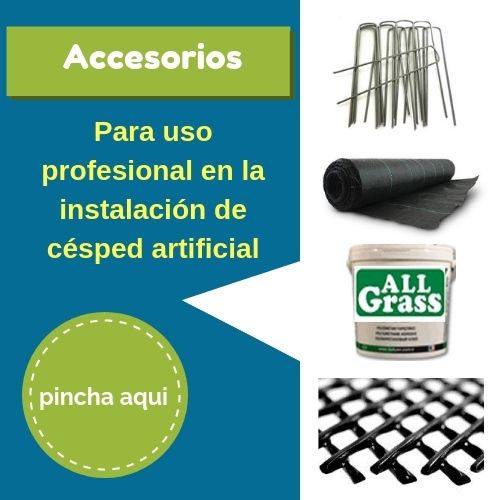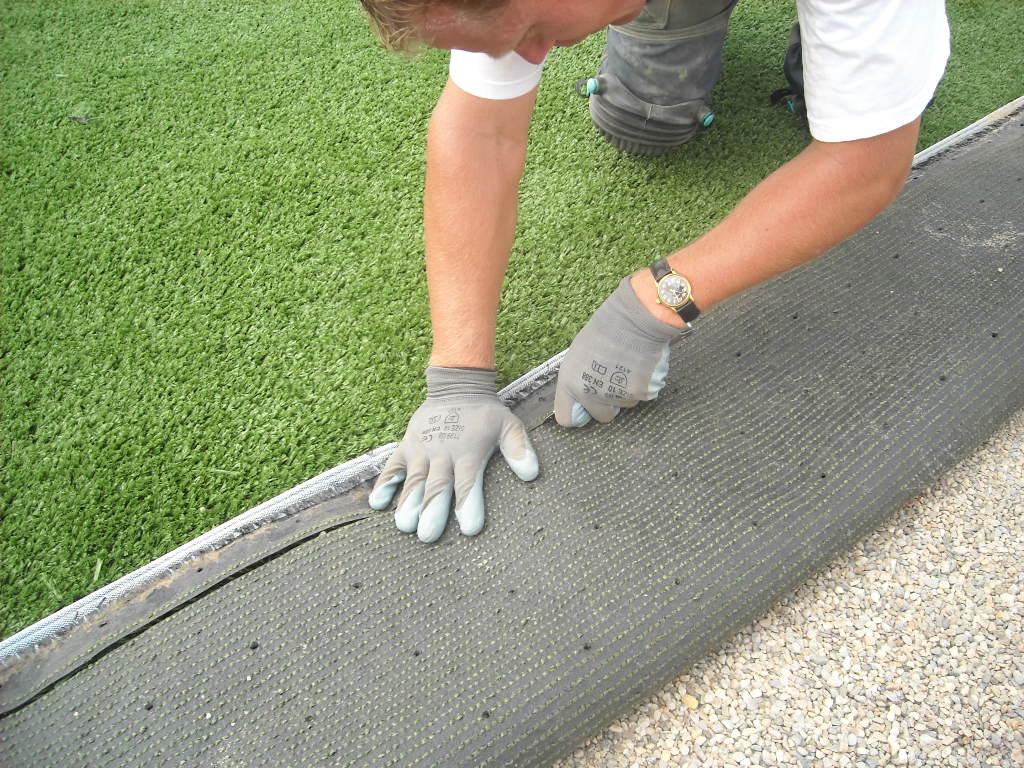GUIDE TO INSTALLING ARTIFICIAL GRASS

Frequently Asked Questions about artificial turf
Before we move on to the Artificial Grass Installation Guide, first of all, we would like to remind you that artificial grass is a sustainable product because it saves 98% of the water needed to maintain the same surface as natural grass.
This represents a saving of approximately 1,400 litres of water per square metre in a year.
Apart from these considerable savings, the use of synthetic grass eliminates the need to use polluting chemical products such as fertilizers, pesticides, CO2 from maintenance machines and, in addition, it is a 100% recyclable product.
.
With the information we provide in this Guide to the installation of artificial turf, you will be easier to carry out this activity.
The installation of synthetic grass is not complicated, but it requires some technique and practice as well as some physical effort.
It is for this reason that we recommend that if you are not used to this type of work, let our professional technicians take care of leaving your garden in impeccable condition in a short time.
Installing artificial grass on small surfaces (up to 25-30mts2) you can do it yourself, for larger surfaces, the handling of the materials and their weights become a physical effort that is best carried out by people who are used to this type of activity.
It is a shame to make an investment in a quality product and that as a result of an inadequate installation, we can not enjoy it for 10 or more years.
Synthetic grass can be laid on any type of soft or hard surface.
If it is on soft ground, it is necessary to prepare it beforehand and install a geotextile or anti-weed mesh prior to the preparation of the gravel base.
For terraces or attics with drains, we recommend our drainage mesh to guarantee the correct flow of water towards the drain and to prevent the suction effect.
Artificial turf is such a versatile and easy to install pavement, that today it is used for multiple applications such as:
- Hotels, schools, social clubs, business facilities
- Fairgrounds and public events in general
- Swimming pool and beach recreation areas
- Passage areas
- Gardens, both private and public
- Ideal for gardens or shady areas
- Highly demanded in small gardens
- Terraces and penthouses
- Interior patios with or without sunlight
- In the Community Zones
- Especially suitable for playgrounds
- Conceived from its beginnings for sports areas
- Urban applications such as roundabouts, medians, parks and public gardens
- Schools and kindergartens
- Public and community pools
- Golf courses
- Sports courts for football, hockey, tennis, paddle tennis and various sports facilities.
Synthetic grass is a polymer that when exposed to the sun and high temperatures as any other surface other than natural grass, it can retain heat.
At ALLGrass, we have synthetic grass models in which the fibres have a matt finish, are less shiny, reflect less light and retain less heat.
A good option is to install an irrigation system in new gardens and maintain it in gardens that already have this system.
This will serve to cool the lawn if it is going to be used in very hot hours and with direct and intense sun exposure.
Other things to consider
The best grass for gardens or terraces is the latest generation of grass which combines different fibres.
The hybrid artificial turf models, which have been on the market for 6 years, are so called because they combine straight monofilament or fibrillated fibres with curly fibres.
These curly fillers can be of the same colour or in brown colours imitating the dry or yellowish strands that are usually seen in a natural lawn and that make them more real.
There are many experiments and combinations that have been made by different manufacturers in the industry with many successes and many failures.
At ALLGrass we currently have several models that are possibly the best that can be seen in the Spanish market this year, Magnum Living Grass, Victoria, Zen or Zaragoza look really natural, have less reflection of light and are soft to the touch without losing the ability to return to its upright position.
The magnifying glass effect is the result of exposing the artificial turf fibres to elements that magnify the V-rays, causing it to have a melted appearance or other alterations.
Glass beakers, mirrors, aluminium or stainless steel plates are some of the most common.
Be careful with leaving this type of material when the sun's rays are very intense, the fibers of the grass can suffer from the magnifying glass effect.
The format of the rolls is key in this Guide to the installation of artificial turf.
Artificial turf rolls are usually presented in 3 types of formats:
- Format bricotienda, are designed to be able to carry in cars and for small surfaces. Usually in 1 or 2 meters wide x 5 meters long.
- Standard format. Rolls of 2 meters x 20 or 25 meters long. Usually used by most installers because they fit in vans and its weight is less.
- Professional format. Rolls of 4 meters x 20 or 25 meters long. Usually used by professional installers with specialized equipment and techniques. It is recommended in case you prefer to make fewer joints when installing the lawn.
To glue the artificial grass strips together, you can use the following options.
There are 2 types of jointing strips for laying artificial turf.
Self-adhesive, single-sided adhesive tape: is prepared for the connection of 2 grass strips.
Self-adhesive, double-sided adhesive band: recommended for joining 2 grass strips and fixing to the concrete or tiled floor.
Professional band of union: It is a joining band made of polymer fabric that is impregnated with bicomponent glue when the artificial grass is installed.
Tips & Tricks
Additional Considerations
Condition of the terrain:
- Currently there is natural grass. In this case, it would be advisable to remove the natural grass and clean the ground of all traces of natural grass, place a geotextile anti-weed blanket and then, prepare a base of gravel, gravel or some similar aggregate compacted with an average of 5cm thick on which will be placed the artificial turf.
- If there is automatic irrigation, there is no problem in leaving it, even sometimes it will serve to refresh the synthetic grass, or, it can be replanted as drip irrigation for the plants of new planters.
- The land is on the ground: In the same way, it is recommended to make the gravel base mentioned in the previous case to place the artificial grass.
This is a very important point in this guide to the installation of artificial turf.
The floor where the artificial turf will be placed must be equipped with a drain or slope for water drainage.
It is advisable to place a 4mm-5mm thick drainage sheet or drainage mesh to facilitate the flow of water into the drainage sump underneath the synthetic turf so that it also benefits from the fact that the flooring dries much faster than if it is laid directly on the ground.
It also has the option of an elastic and padded base of 20mm thick with cells that allow drainage and can be placed under the grass, it will have an even safer surface against the typical falls of children when playing.
Tips:
- It is NOT necessary to glue the artificial turf to the ground with the same glue with which the joints are made, if you do, you may have problems when you want to replace it. You can secure the pavement to the ground with putty for exteriors and, edges and corners.
- Placing planters and other weighted elements is an option in windy places.
We must say that in recent years and with the arrival of new generations of artificial turf, the use of this material has become an option.
With regard to the silica sand in residential applications such as gardens and terraces, when the models are filled with curly and very dense fibres, they can be used for can do without this ballast.
Silica sand ballast in synthetic turf is widely used in multipurpose or sports applications and is part of an established system to give anchorage and stability to the surface.
It is basic that the strips of grass go in the same direction of the "hair" or fiber. Although in types of grass with very high heights or with a lot of density it is possible that they can be placed in a different direction.
A trick that can be applied, is to place a planter as a separation in case you are forced to place the lawn in another direction.
The care or maintenance of the synthetic grass, is limited to have a periodic cleaning and take the usual hygiene habits that would be done in any surface. We can summarize them in:
- Sporadic brushing of the surface.
- Application of a long-lasting herbicide to prevent weeds from appearing, especially in the spring and autumn seasons.
- Sweeping with a long bristle brush to remove organic matter such as leaves, dust or animal hair.
- Cleaning with water of the areas that have become dirty as a result of mud, animal droppings, etc. and a general watering to remove dust. Cleaning detergents that do not contain abrasive elements in their chemical composition can be used to remove stains and bad smells.
The base support of the artificial turf, called backing, consists of a woven fabric known as geotextile, usually made of polypropylene.
This material can be reinforced with weft yarns or by adding additional layers.
A good backing is important to ensure the stability of the artificial turf.
This support is resistant to various weather conditions, including rain, heat and frost.
Artificial turf with good backing is of great importance for the lifetime of the artificial turf.
The 2 most popular types of backing in the industry are latex and polyurethane. BOTH offer the same basic technical characteristics to guarantee the anchoring of the fibre to the support base.




